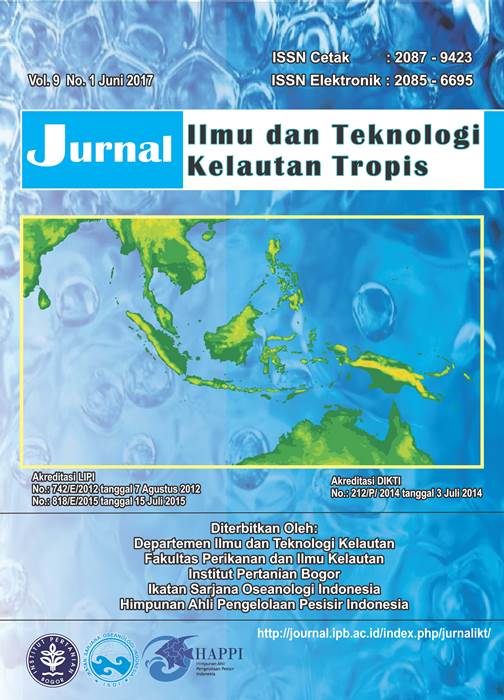REPRODUCTIVE BIOLOGY OF POKEA CLAM Batissa violacea var. celebensis, VON MARTENS 1897 AT LASOLO ESTUARY, SOUTHEAST SULAWESI
Abstract
Pokea clam Batissa violacea var. celebensis von Martens 1897 that inhabits the substrates of some estuaries in Southeast Sulawesi has a tendency to have different reproductive pattern. The aim of this study was to determine the sex ratio, gonadal maturity stage (TKG), gonadal maturity index (IKG) and the size at first gonad maturity of pokea in Lasolo estuary, Southeast Sulawesi. Samples were randomly collected using a traditional fishing gear called tangge. Sex ratio, TKG, IKG, and the size at first gonad maturity were determined using standard methods and formulas and then analyzed using Chi Square, quantitative description and non-linear regression. The results showed that the number of males were higher than the numbers of females, ranging from 71.85-89.84% and 10.16-28.15%, respectively. Gonadal maturity development of male and female occured simultaneously. Early gonadal maturity stage began in January. Spawning occurs twice, beginning with maturity in April and spawning in May and then again maturity in July and spawning in July until October. IKG values of male and female were relatively the same ranging from 2.56-31.92. The males matured earlier than the females at size 1.95 cm and 2.15 cm, respectively.
Keywords: female, gonad, male, clam, maturity, spawning
Authors
This work is licensed under a Creative Commons Attribution 4.0 International License.
Jurnal Ilmu dan Teknologi Kelautan Tropis i is an open-access journal, meaning that all content is freely available without charge to the user or their institution. Users are allowed to read, download, copy, distribute, print, search, or link to the full texts of the articles in this journal without needing to request prior permission from the publisher or the author.
All articles published by Jurnal Ilmu dan Teknologi Kelautan Tropis are licensed under the Creative Commons Attribution 4.0 International License. This allows for unrestricted use, distribution, and reproduction in any medium, provided proper credit is given to the original authors.
Authors submitting manuscripts should understand and agree that the copyright of published manuscripts is retained by the authors. Copyright encompasses the exclusive rights of authors to reproduce, distribute, and sell any part of the journal articles in all forms and media. Reproduction of any part of this journal, its storage in databases, and its transmission by any form or media is allowed without written permission from Jurnal Ilmu dan Teknologi Kelautan Tropis.


